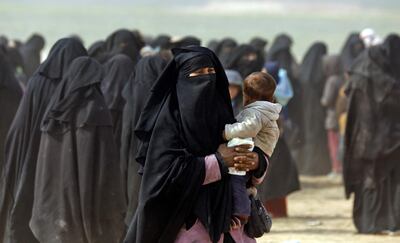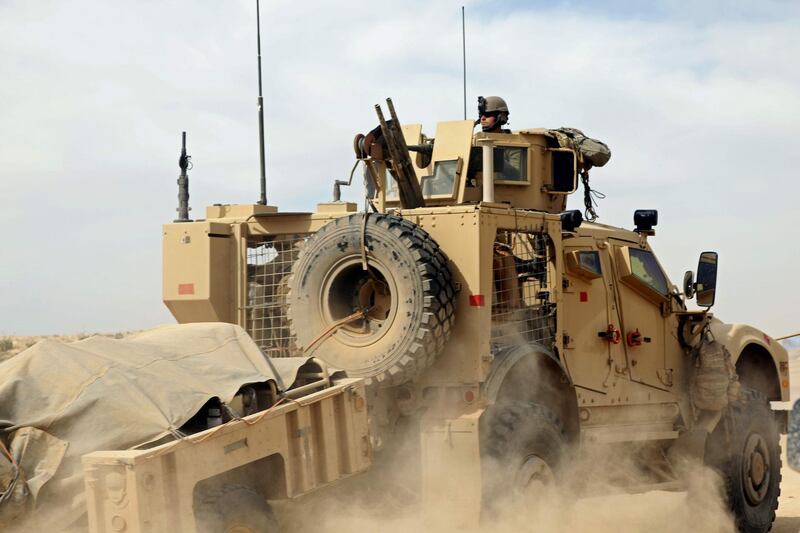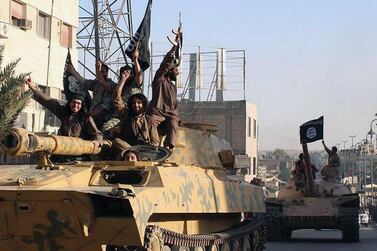ISIS fighters used tunnels and suicide bombers in a desperate defence of their last patch of territory in eastern Syria on Thursday.
Kurdish-led forces closed in on the small town of Baghouz where the ISIS fighters have made a stand with their relatives and encountered hundreds of famished and dishevelled people turning themselves in.
"The fighting is fierce," said Adnan Afrin, a spokesman for the Syrian Democratic Forces, the Kurdish-Arab outfit that has spearheaded the campaign against ISIS with backing from a US-led coalition.
"There is significant resistance," he said, speaking from Al Omar oil field, the main staging base for the SDF's offensive against the last shred of the original ISIS "caliphate".
The few ISIS hundred fighters in the area near the Iraqi border have launched bruising counter-attacks in recent days, Mr Afrin said.
He said SDF forces tuning their walkie-talkies to the militants' frequencies "can hear them speak in Arabic but also in Turkish, French and English".
The militants are clinging to about one square kilometre in the town's built-up area, as well as to an adjacent camp, where a number of civilians are believed to be gathered.
Mr Afrin said it was impossible to provide accurate figures but he estimated the total number of fighters, men and women, at about 1,000.
"There are many tunnels in Baghouz now. This is why the operation is dragging on. There are many suicide bombers attacking our positions, with explosives-laden cars and motorbikes," he said.
He said two such suicide attacks were carried out by women on Tuesday but he would not provide any figures on casualties among SDF ranks.
Hundreds of people continued to trickle out of the last ISIS redoubt every day, trudging up a dirt road to a collection point where SDF fighters and volunteers provide first aid and carry out a first screening.
Many of them had to sleep outside in the cold to reach that point, where a lucky few got tents while the rest were spread out on cheap blankets.

"The kids were crying all night from the cold," said Fatima, an Iraqi woman from Baghdad who fled Baghouz with her four children, all under 15.
"This is the second night we sleep outside. There was so much bombing in Baghouz that it was safer for us to sleep in the open," she said.
The US-led coalition is carrying out air strikes on the area while its forces are also present on the ground, sifting through the displaced for wanted extremists.
Once the adult men have been separated from their families, foreign and SDF officers thumb through pictures on smart phones to ask new arrivals about wanted ISIS leaders.
The elusive Iraqi-born ISIS leader, Abu Bakr Al Baghdadi, is not believed to be in Baghouz.
Several known ISIS figures have emerged from the dregs of the "caliphate" in recent days however, including German Martin Lemke and Frenchman Quentin Le Brun.
A rift appears to have grown between foreign members of ISIS who have nowhere to hide and local fighters who are attempting to blend back into the population as the organisation goes underground again.
The "caliphate" Baghdadi proclaimed in mid-2014 once spanned large areas of Syria and Iraq and administered millions of people.
It printed its own schoolbooks, produced oil, collected taxes and minted its own currency, in a brief but unprecedented experiment in statehood.
Successive offensives in Iraq and Syria have shattered the proto-state, which lost its key cities one after the other and has since late 2017 been confined to its traditional stronghold in the Euphrates River valley.
An official declaration of victory against ISIS is expected in the coming days, a move of mostly symbolic value as the death certificate of the "caliphate".
While surviving ISIS fighters on both sides of the border will no longer hold fixed positions, the organisation will remain a threat.
The United States is expected to pull its troops out of Syria within weeks, creating a vacuum that risks allowing ISIS to rebuild and project new ambitions.
The Kurds are also afraid they will have to give up the autonomy they acquired and be left exposed to a military offensive by their arch foe Turkey.






